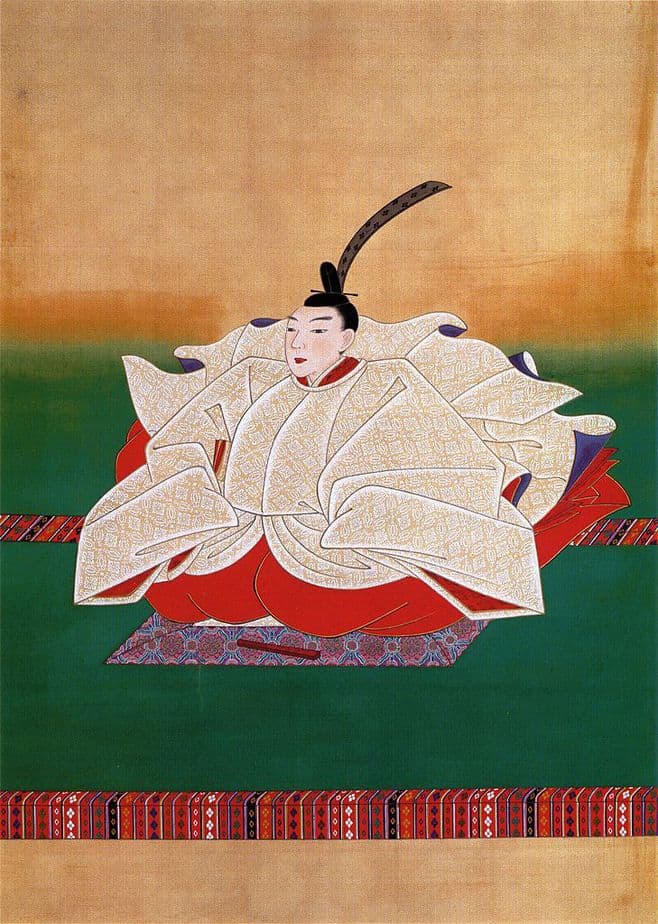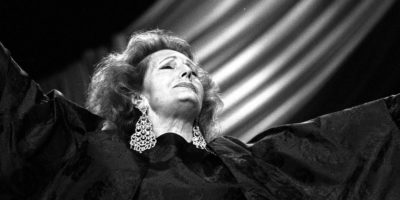20 most famous Japanese Emperors and Kings
*Originally published by Pamela in April 2020 and Updated by Vanessa R in October 2022 and Updated by Vanessa R in October 2023
20 most famous Japanese Emperors and Kings
The Chrysanthemum Throne features the longest continuous imperial line of succession in the world. It dates back to 660 BC. With over a hundred different emperors across its history, the Japanese imperial throne is bound to have an intriguing history.
From the reign of one of the few Empresses to the present-day academics of Emperor Akihito, the history of the imperial family is one with many different facets. Sometimes the emperors happily sat in the background of political affairs; at other times, they were at the forefront of nationalistic cult followings. Japanese emperors have led varied lives, so let’s take a look at the 20 most famous Japanese emperors and kings.
1. Emperor Jimmu
Reigned: 660–585 BCE
Emperor Jimmu, or Jinmu-Tennō, was the first emperor of Japan and the founder of the ‘Imperial House of Japan.’ It seems he lived in the Yayoi Period, Japan’s “Iron Age.” It is said that his reign began in 660 BC and that he was the descendant of the sun goddess Amaterasu-ōmikami, through her grandson Ninigi-no-Mikoto, and also a descendant of the storm god Susanoo.
His main accomplishment was the military campaign launched from Hyuga near the Seto Inland Sea when he captured Yamato and turned it into his headquarters. February 11 is now a national holiday in Japan and is known as National Foundation Day, in his memory. It honours the foundation of Japan’s imperial line, which continues to date.
2. Emperor Meiji
Reigned: 1867–1912
Emperor Meiji, also known as Meiji the Great, was a Japanese monarch who ruled from February 1867 until his death in July 1912. The 122nd Emperor of Japan according to the traditional order of succession, he reigned over a period in history that has come to be known as the Meiji period, during which the Empire of Japan witnessed a radical transition from an isolationist feudal state to industrialized world power.
When he was born in 1852, Japan was a feudal country without any significant industry. Much of the country’s political and military power was hoarded by the Tokugawa shogunate and the daimyōs, who controlled the country’s’ 250 plus decentralized domains. During his reign, Japan experienced an immense political, economic, and social revolution and became one of the great powers in the world stage. As part of the modern tradition, he received a posthumous name, Emperor Meiji, which was the name of the era coinciding with his reign. He also had a personal name, Mutsuhito, but it was not used in any formal affair. During his lifetime, he was simply referred to as “The Emperor”.
3. Emperor Taishō
Reigned: 1912–1926
Emperor Taishō or Taishō Tennō, meaning “Great Righteousness,” was the 123rd emperor of Japan. He ruled over the nation from 1912 to 1926. He was born Prince Yoshihito. Having contracted a critical illness during his infancy, he suffered from physical and neurological problems all his life. He was declared the crown prince after the deaths of his two elder brothers. As a young prince, Yoshihito received his education in the school for the children of the nobility but due to his diminished mental capabilities, he could not continue his formal education. Much of his childhood was spent nursing his health in the various summer palaces of the imperial family. As an emperor, his reign was distinctly different from that of his father, Emperor Meiji. Emperor Meiji had a commanding presence and his rule was distinctly authoritarian. Emperor Taishō, however, was usually kept away from the public eye and rarely participated in political affairs. Japan experienced a distinct move towards democracy during this period, and hence his reign is also known as the Taishō democracy. After the death of the emperor, his first son Hirohito took over the reins of the Japanese empire.
4. Akihito
Reigned: 1989–2019
A member of the ‘Imperial House of Japan’, Akihito served as the 125th Emperor of Japan, from 7th January 1989 to 30th April 2019. He was one of the very few emperors of the modern world who earned the reputation of being an ideal leader. Akihito’s peace-loving nature became evident when he decided to make peace with China and other Asian nations almost immediately after succeeding his father. Even the leaders of other powerful nations and sections of media have praised Akihito for being a humble man despite hailing from a royal background. When the devastating Tsunami sent shockwaves across Japan, Akihito’s inspiring speech instilled a ray of hope in the lives of many people who were shattered by the catastrophe. Other than being a member of the ‘Imperial House,’ Akihito is also known for being a scholar. Many of his research papers on molecular biology have been published in various scientific journals. He was also involved in specialized studies concerning ‘Gobiidae,’ a form of fish, and its taxonomy.
5. Hirohito
Reigned: 1926 – 1989
Hirohito was the longest-living ruler in modern history; he served as the emperor of Japan for nearly 63 years. By ascending the ‘Chrysanthemum Throne’ following his father’s death, he became the 124th emperor of Japan at a time when Japan was undergoing a financial crisis and when military power was on the rise within the government. Though he never openly supported the hideous actions of the overpowering military, he never legally opposed their actions as well, making his involvement in the matter highly debatable.
By entering a treaty with Nazi Germany and Fascist Italy, he was successful in invading and seizing numerous regions in Southeast Asia and the Pacific, including Dutch East Indies, New Guinea, Philippines, and British Singapore. He was also successful in launching a surprise bombing on the US naval base at Pearl Harbor. However, the Americans retaliated and defeated the Japanese troops by dropping atomic bombs on Hiroshima and Nagasaki. He became a popular national symbol after the war. He administered a democratic rule, making public appearances and permitting photos and stories of the royal family to be published in newspapers and magazines. He also made efforts to resurrect Japan after the war and helped rebuild Japan, turning it into the world’s second-largest economy. He also helped establish political stability in the country.
6. Naruhito
Reigned: 2019–present
Naruhito is the Emperor of Japan. He became the 126th emperor of Japan on 1 May 2019 after his father, former Emperor Akihito, abdicated the throne on April 30, 2019. Naruhito is the first emperor of the post-World War II era to ascend the ‘Chrysanthemum Throne.’ In 2012, Naruhito was given the responsibility of handling the Emperor’s duties for two weeks while his father recovered from heart bypass surgery. As the crown prince, Naruhito has travelled all over the world. His 2009 trip to Vietnam was the first one to a communist nation. This week-long trip marked the 35th anniversary of diplomatic ties between Japan and Vietnam. In 1993, Naruhito published a memoir about his experiences during his two years stay at Oxford. In 1989, he was honoured by the ‘Scout Association of Japan’ with the ‘Golden Pheasant Award.’ He also holds the ‘Golden Medal of Merit’ of the ‘Japanese Red Cross Society’.
7. Emperor Kōmei
Reigned: 1846-1867
Emperor Kōmei was the 121st Emperor of Japan. During his reign, there was a lot of internal turmoil as a result of Japan’s first major contact with the United States and the subsequent forced reopening of Japan to western nations. This brought an ending to 220 years of national seclusion. Emperor Kōmei did not care much for anything foreign, thus he opposed opening Japan to Western powers. His reign would continue to be dominated by rebellion and partisan conflicts eventually culminating in the collapse of the Tokugawa shogunate shortly after his death and the Meiji Restoration at the beginning of the reign of his son and successor Emperor Meiji.
8. Emperor Ninkō
Reigned: 1817 – 1846
Emperor Ninkō was the 120th Emperor of Japan. His reign spanned the years from 1817 until he died in 1846, and saw a further deterioration of the ruling Shōgun’s power. Famine, corruption and increasing Western interference helped to erode public trust in the government. Emperor Ninkō attempted to revive certain court rituals and practices upon the wishes of his father. His family included fifteen children from various concubines, but only three of them lived to adulthood. His fourth son, Imperial Prince Osahito became the next Emperor upon his death in 1846.
9. Emperor Kōkaku
Reigned: 1780 – 1817
Emperor Kōkaku was the 119th Emperor of Japan. Kōkaku is the founder of the dynastic imperial branch which currently sits on the throne. Kōkaku had one spouse during his lifetime and six concubines who gave birth to sixteen children. Only one son survived into adulthood and eventually became the next Emperor. Genealogically, Kōkaku is the lineal ancestor of all the succeeding Emperors up to Emperor, Naruhito.
10. Emperor Go-Momozono
Reigned: 1771 – 1779
Emperor Go-Momozono was the 118th Emperor of Japan. He was named after his father Emperor Momozono. Go-Momozono became Emperor in 1771 and events during his reign were confined to a series of natural calamities that occurred in 1772, aside from that, the political situation with the Shōgun was quiet. Things came to a head towards the end of Go-Momozono’s life as it dawned on him that the Emperor had no eligible successor. As a result, he hastily adopted a son on his deathbed who later became the next Emperor.
11. Emperor Kammu
The Japanese city of Nara is where Emperor Kammu was born as Kammu Tenno Yamanobe in 737. Heian-Kyo served as the location of the Japanese Capital until 1868, and he was in charge of building it there. Heian period origins were due to Kammu accomplishment (794 – 1185).
In 781, Kammu was installed as the new emperor of Japan, and over the course of several centuries, he rose to become one of the nation’s most powerful leaders. Following his election, the leaders of the Buddhist religion attacked his government because they were granting taxes immunity and had political aspirations.
In order to prevent further Buddhist institutions from being built, as well as to prohibit the donation or sale of property for their construction, Kammu had to act quickly and draft legislation. As a practising Buddhist, Kammu encouraged the expansion of two Buddhist sects because they fought the other Buddhist sects that he perceived as a danger to his governmental authority.
12. Emperor Sudo
During his lifetime, Emperor Sudo never held the throne. In actuality, he was only crowned an emperor after passing away. When he was alive, Sudo went by the name Prince Sawara, and his older brother, Emperor Kanmu, held the throne. With his eyes set on the throne, Sawara planned the assassination of Fujiwara no Tanetsugu, one of his brother’s favourite bureaucrats. As retribution, Kanmu killed and banished Sawara’s accomplices and sent his shamed brother to live on the faraway island of Awaji.
Before reaching Awaji, Prince Sawara starved to death, but the emperor’s problems didn’t end there. Prince Ate, Kanmu’s heir, also got unwell after Sawara’s passing, and the empress eventually passed away. Prince Sawara’s spirit was said to stalk the imperial family after Prince Ate received no benefit from offerings and prayers. Kanmu anxiously set out to placate his brother’s soul and erected a temple in his memory.
13. Emperor Go-Daigo
Shoguns, or military rulers, ruled Japan from 1185 and 1333 during the Kamakura period. The shogun actually held the reins of power, albeit the Japanese emperor continued to rule.
Emperor Go-Daigo assumed the throne in 1318, hoping to recapture the level of power his ancestors once exercised. Following a series of unfortunate events, one of which forced the emperor into exile, Go-Daigo and his allies launched a revolution that resulted in the overthrow of the government in 1333. Go-Daigo reigned once more as emperor for the following three years as a result of the Kenmu Restoration. Even the samurai were turned off by his policies, but they were still his loyalists.
14. Emperor Go-Komatsu
It was originally agreed that someone from that family would succeed Go-Komatsu when the last Southern Court emperor abdicated in 1392. The succession would alternate between the two separate factions in order to appease both groups and prevent one dynasty from controlling the throne.
While that was the arrangement, it was never upheld. When Emperor Go-Komatsu abdicated in 1412, his son Shoko succeeded him. Despite being the rightful line, the Southern Court dynasty never succeeded in seizing power, and all succeeding Japanese monarchs have been from the Northern Court.
15. Emperor Yozei
The untamed Emperor Yozei must have been an absolute nightmare for the sophisticated, delicate court of the Heian era (794-1185). When Yozei was just nine years old, he was crowned emperor. He had come up with some disturbing ways to amuse himself by the time he was a teenager.
The young monarch revelled in the slaughter of animals, putting dogs against monkeys and ordering snakes to eat frogs. Evidently, he found entertainment outside of animals. Yozei is rumoured to have once randomly slain a courtier with a sword or his own fists, though specifics are sketchy. The murder was covered up by the government, but many of Yozei’s elders may have reached their breaking point because of this.
16. Emperor Toyotomi Hideyoshi
Emperor Toyotomi Hideyoshi, born a peasant, was a powerful figure in Japanese history. His intelligence, charisma, and military prowess led him to become the most powerful man in Japan. Hideyoshi was a brilliant strategist, tactician, and master of psychology, leading his forces to victory in numerous battles and uniting Japan for the first time in centuries.
In 1588, he launched a massive invasion of Korea, which was a major failure. Despite the defeat, Hideyoshi showed great courage and determination, refusing to give up. His legacy is complex and controversial, as he was both a brilliant military leader and a ruthless dictator. He was also a patron of the arts and culture, building numerous castles and temples and promoting the development of the Japanese tea ceremony and Noh theatre.
17. Emperor Shōwa
Emperor Shōwa, also known as Hirohito, was the 124th emperor of Japan from 1926 to 1989. His reign was marked by political and economic instability, a growing movement for democracy and social reform, and the increasing power of the Japanese military. In 1931, Japan invaded Manchuria without Hirohito’s approval, marking the beginning of Japan’s militaristic expansion in Asia.
In 1937, Japan invaded China, resulting in the Sino-Japanese War, which lasted eight years and resulted in millions of deaths. In 1941, Japan attacked the United States and entered World War II, but Hirohito was unable to stop the military. Japan surrendered to the Allied Powers in 1945, and Hirohito narrowly avoided being tried as a war criminal. After the war, Japan experienced rapid democratization and economic development, with Hirohito playing a symbolic role in the reconstruction. His legacy continues to be debated by historians and the Japanese people.
18. Empress Kōken

http://go.yenching.edu.hk/mikado.htm, Public domain, via Wikimedia Commons
Empress Kōken (718-770 AD), also known as Empress Shōtoku, was the 46th and 48th monarch of Japan. Born to Emperor Shōmu and Empress Kōmyō, she was a devout Buddhist and oversaw the construction of numerous temples and shrines, including the Tōdai-ji Temple in Nara. She was a patron of arts and culture, promoting the development of Japanese tea ceremony and Noh theatre. In 765 AD, she ordered the construction of a giant bronze Buddha statue at Tōdai-ji Temple, one of the largest in the world. Her reign was marked by political turmoil and religious conflict, with her support for Buddhist monk Dōkyō leading to conflict with the Fujiwara clan. In 764 AD, Kōken’s supporters overthrew the Fujiwara clan in a civil war, and she reascended as Empress Shōtoku. She was a complex and contradictory figure, balancing her devotion to Buddhism with her political ruthlessness.
19. Empress Jitō
Empress Jitō was the 41st monarch of Japan and the third female emperor in Japanese history. She ruled from 686 to 697 AD during a period of political turmoil. After Emperor Tenmu’s death, Jitō continued her husband’s work and stabilised the country. In 690 AD, she ordered the construction of Fujiwara-kyō, the first capital city in Japan to be laid out in a grid pattern and have a permanent government building.
Fujiwara-kyō was a major centre of government, culture, and trade, and was a wise decision that promoted Japan’s development. Jitō was a skilled politician, wise leader, and patron of arts and culture. She oversaw the construction of temples and shrines and promoted the development of the Japanese tea ceremony and Noh theatre. She abdicated in 697 AD and died in 703 AD.
20. Emperor Tokugawa Ieyasu

Editor = Dalton, W. / (Dalton, William)., Public domain, via Wikimedia Commons
Tokugawa Ieyasu, born into a minor daimyo family, was a powerful military strategist and politician who played a crucial role in unifying Japan after the Sengoku period. He rose through the ranks of the Japanese military and fought in numerous battles during the Sengoku period. In 1600, he defeated his rivals at the Battle of Sekigahara, effectively bringing Japan under his control.
Ieyasu was appointed shogun in 1603 and implemented reforms to stabilise and strengthen Japan, including a centralised government, a system of hereditary daimyo, and economic development. He also instituted a policy of isolation, closing Japan off from the outside world for over 200 years. Although he died in 1616, his legacy continued to shape Japan for centuries. The Tokugawa shogunate ruled with an iron fist, but it brought peace and prosperity to the country. Ieyasu is considered one of the most important figures in Japanese history, known for his military strategy, wise politics, and skilled administration.
Planning a trip to Paris ? Get ready !
These are Amazon’s best-selling travel products that you may need for coming to Paris.
Bookstore
- The best travel book : Rick Steves – Paris 2023 – Learn more here
- Fodor’s Paris 2024 – Learn more here
Travel Gear
- Venture Pal Lightweight Backpack – Learn more here
- Samsonite Winfield 2 28″ Luggage – Learn more here
- Swig Savvy’s Stainless Steel Insulated Water Bottle – Learn more here
Check Amazon’s best-seller list for the most popular travel accessories. We sometimes read this list just to find out what new travel products people are buying.














